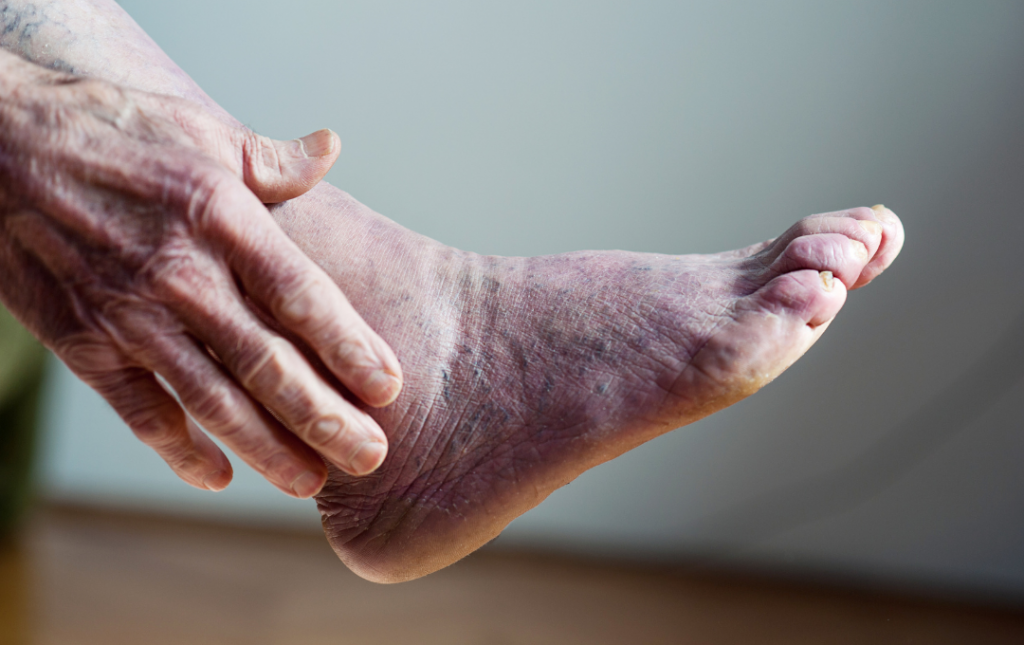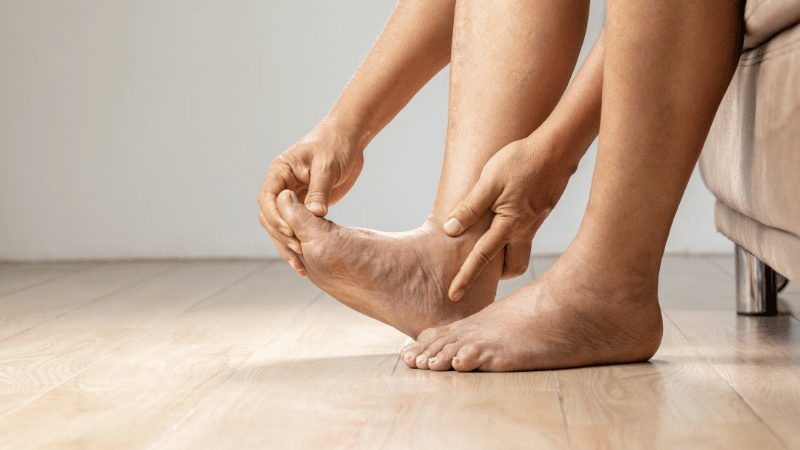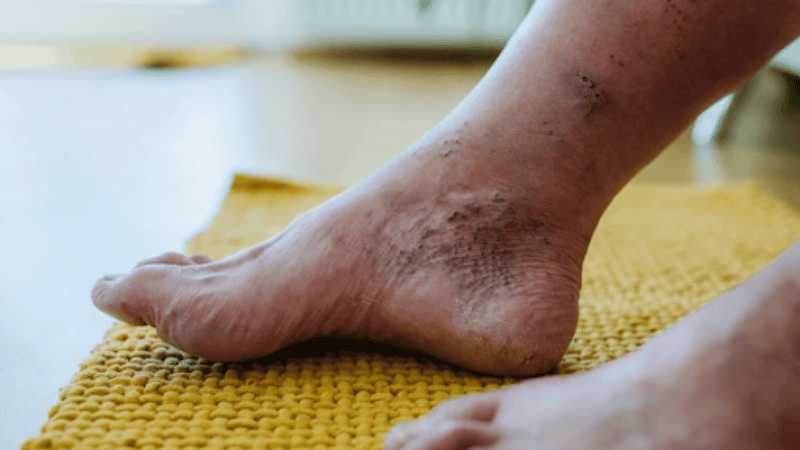Most people have had blue, discolored hands and feet after spending time in colder weather. Cold weather constricts your blood vessels, resulting in blue, purple, or pale discoloration. Certain medications or unexpected bruising can also cause the feet to turn blue. These causes aren’t concerning on their own, but may signal an issue if accompanied by other symptoms, such as leg pain, swelling, or numbness.
However, if you notice persistent blue feet and discoloration, it may be a sign of poor circulation or an underlying health issue, such as peripheral artery disease (PAD).
In this blog, we’ll discuss the causes of blueness in the feet and highlight warning signs to monitor for when it’s time to seek medical attention for an accurate diagnosis.
What Blue Feet May Indicate
Blueness in the feet can vary in severity. When temporary discoloration is caused by cold exposure or keeping the feet elevated for too long, it typically resolves quickly after movement or warming up the body.
However, persistent, worsening, or unexplained blue foot discoloration may signal a circulatory issue. Additional warning signs can include:
- Coldness or numbness in the toes or feet
- Shiny or thinning skin
- Slow-healing wounds or ulcers
- Leg or foot pain when walking
Common Causes of Blue Feet and Toes
The cause of blue feet and toes can vary from minor to severe. Here are some of the common causes to consider:
- Peripheral artery disease (PAD): Narrowed arteries restrict blood flow to the lower extremities, leading to pain, slow-healing ulcers, and blueness.
- Cold exposure: Exposure to freezing temperatures can cause temporary vasoconstriction, causing a bluish hue.
- Prolonged sitting or crossing legs: Sitting in a certain position for long periods can reduce blood flow to the legs and feet, leading to discoloration and a tingling sensation.
- Raynaud’s phenomenon: This condition causes blood vessel spasms in the extremities, often triggered by cold or stress, leading to temporary discoloration and numbness.
- Venous insufficiency: Blood pools in the legs due to poor vein function, leading to discoloration, numbness, and pain.
- Blood clots or embolisms: Clots and embolisms can cause a sudden onset of blueness. If you experience pain, swelling, and sudden discoloration in a localized area, seek medical attention.
Why Poor Circulation Can Lead to Bluish Feet
The medical term for blue discoloration in the feet, toes, or fingers is peripheral cyanosis. This is due to a lack of oxygenated blood in your lower extremities caused by:
- Atherosclerosis: The narrowing or blockage of arteries caused by plaque accumulation along the inner arterial walls, resulting in restricted blood flow. If blue or purple discoloration is accompanied by other symptoms, such as leg pain, swelling, or weakness, it may be a sign of a more serious circulatory issue, such as peripheral artery disease (PAD).
- Embolism: The obstruction of an artery by an object, such as a blood clot or air bubble.
- Medication: Blood thinners and medications that break down blood clots can also cause blue toes.
Peripheral Artery Disease and Blue Feet
Blue feet and toes can be a sign of peripheral artery disease (PAD). PAD restricts blood flow, particularly in the legs and feet, and can lead to insufficient oxygen reaching the tissues. This causes the skin to appear blue, purple, or even pale. Recognizing changes in foot color can be an important early indicator of PAD.
Leg and foot discoloration is one of the many symptoms of peripheral artery disease (PAD). Other symptoms of PAD include:
- Leg pain or cramping
- Leg heaviness or fatigue
- Coldness in one leg or foot
- Sores on the toes, feet, or legs that won’t heal
- Leg hair loss
- Slowed toenail growth
- Erectile dysfunction
If you notice any blue discoloration or leg pain, schedule a consultation with a vascular specialist. Early intervention can help restore mobility and prevent the disease from worsening.
Take The PAD Symptom Risk Assessment
Blue Feet in the Elderly
Age-related changes to blood vessels, such as arterial stiffening, can increase the risk of PAD and chronic venous insufficiency, both of which can contribute to blue feet in a geriatric or elderly population.
Many individuals write off pain or blueness in the lower extremities as a typical sign of aging. This can lead to a delayed diagnosis and increase the risk of developing late-stage PAD symptoms.
If you notice your feet turning blue, schedule a consultation with a vascular specialist for a thorough examination and diagnosis.
When to Worry About Blue Feet
Blue discoloration of legs should always be taken seriously, especially if it’s accompanied by pain or numbness.
Sudden onset of blue discoloration may indicate a severe issue such as an arterial blockage or blood clot. If you notice blue discoloration localized in one area or the discoloration does not resolve after moving to a warmer place or changing your position, consult with a vascular specialist.
Treating PAD & Blue Feet
If you’ve been diagnosed with peripheral artery disease, non-surgical treatments can provide relief. USA Vascular Centers offers the following minimally invasive, outpatient PAD treatments nationwide:
- Angioplasty: A tiny catheter with a small balloon attached to the tip is inserted into the affected artery. At the site of the blockage, the balloon is inflated to push the plaque against the artery walls and restore blood flow.
- Stent Placement: A stent is a small metal tube designed to expand; when placed in an affected artery, it provides permanent support to prevent future narrowing.
- Atherectomy: A tiny catheter is inserted near the groin or upper thigh. The catheter has a blade or laser that removes plaque accumulation inside the peripheral artery.
After a thorough screening and review of your medical history, a vascular doctor will determine which treatment is best for your condition.
Improve Blue Feet with USA Vascular Centers
Persistent blueness and discoloration in the feet may be a warning sign of PAD and should be evaluated by a vascular specialist. USA Vascular Centers offers non-surgical, image-guided diagnostic methods and personalized treatment options for individuals with PAD. Our minimally invasive treatments can help improve blood flow and circulation in the lower extremities. We have locations throughout the United States with experienced vascular specialists ready to help.
Call us at 888.773.2193 or schedule a consultation online today.
Frequently Asked Questions
Why are my feet discolored and cold?
There could be several serious and minor reasons why your feet are discolored and cold, including peripheral artery disease (PAD), which can restrict blood flow and reduce the delivery of oxygen-rich blood to the legs and feet.
When should I be worried about purple or blue toes?
If your toes are constantly purple or blue and cold to the touch, this may be cause for concern. Persistent or worsening discoloration may indicate an underlying vascular condition and should be evaluated by a specialist.
Can blue discolored feet be dangerous?
Blue, discolored feet can be a sign of danger because they may indicate a lack of blood flow to the lower extremities. If left unaddressed, prolonged lack of blood flow may lead to tissue damage in the feet, potentially requiring more intensive medical intervention.
How do you fix foot discoloration?
In some cases, warming up discolored blue feet may improve circulation. However, persistent symptoms require professional medical evaluation to rule out underlying conditions and to create an effective management plan.




